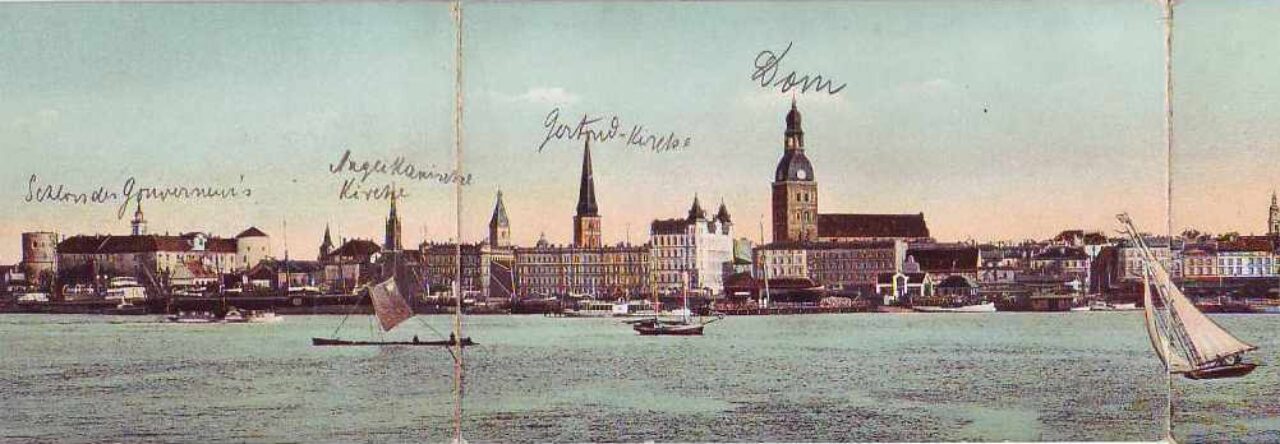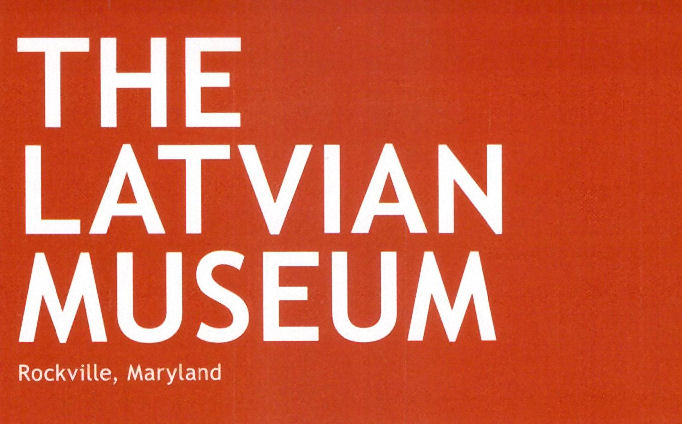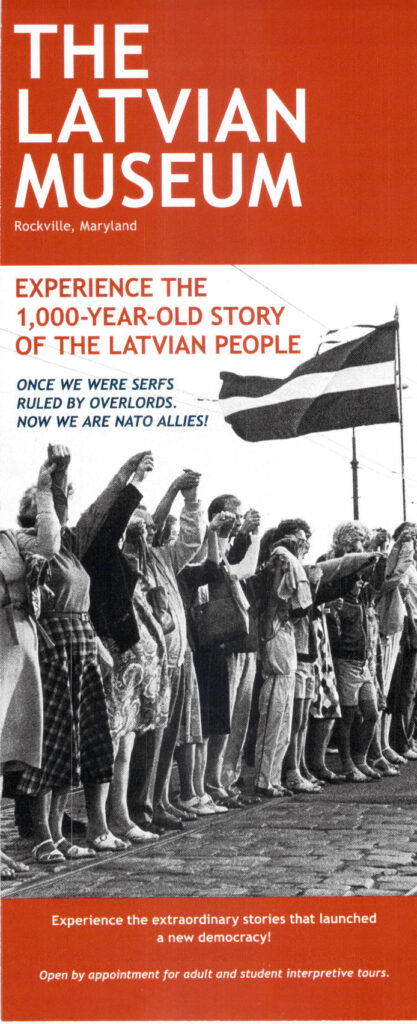
Arrival
December 4, 10:54am. Just in time for the 11:00 church service. I was glad to be able to make the time (325 mile round trip!) to attend the reopening of the Latvian Museum at the American Latvian Association in Rockville, Maryland. And through sheer luck, as I went down the aisle along the left side of church, finally finding an open pew seat and asking if it was taken, it was — by the very couple I had hoped to meet at the opening: JBANC managing director Karl Altau and wife Rita Laima née Bērziņa. I accepted their invitation to scoot in and sit next to them. What were the chances? In Latvian circles, more common than one might think.
Service
Growing up, the church was the center of the Latvian community simply as a matter of practicality. Every weekend during the school year featured Latvian school. Celebrating Latvian holidays, Latvian Independence Day,… all took place in the church events hall. Now, two generations later, I was glad to see that community relationship and tradition continues in the Washington DC area since I expect we will be joining the church at some point.

The second Sunday of Advent service focused on John the Baptist and included a reading from John 1:19-28 (in both Latvian and English):
19 Now this was John’s testimony when the Jewish leaders in Jerusalem sent priests and Levites to ask him who he was. 20 He did not fail to confess, but confessed freely, “I am not the Messiah.” 21 They asked him, “Then who are you? Are you Elijah?” He said, “I am not.” “Are you the Prophet?” He answered, “No.” 22 Finally they said, “Who are you? Give us an answer to take back to those who sent us. What do you say about yourself?” 23 John replied in the words of Isaiah the prophet, “I am the voice of one calling in the wilderness, ‘Make straight the way for the Lord.’” 24 Now the Pharisees who had been sent 25 questioned him, “Why then do you baptize if you are not the Messiah, nor Elijah, nor the Prophet?” 26 “I baptize with water,” John replied, “but among you stands one you do not know. 27 He is the one who comes after me, the straps of whose sandals I am not worthy to untie.” 28 This all happened at Bethany on the other side of the Jordan, where John was baptizing.
For those in attendance for the Latvian Museum opening and reception following, it was also a parable for the life and service of Lilita Bergs, founder (1978) and Director of the museum until her unexpected passing during the summer as the renovations approached completion. Selfless service, a tireless champion for the promulgation of knowledge of Latvian history, someone who eschewed any aggrandizement of her position,…. Those who knew her could not help but draw parallels to the life of John, celebrating a life of service to a far greater cause than oneself, and shared in acknowledging her presence in spirit.
Opening celebration

The full title of the day’s celebration was: “Tūkstots gadu latvju vēsture saritināta 800 kvadrātpēdu kamolā — ALA paspārnē jaunveidots Latviešu muzejs”, A millennium of Latvian history bndled up into an eight-hundred square foot ball [typically of string or yarn] — the newly remade Latvian museum under the wing of ALA (American Latvian Association).
The host for the celebration was Pēteris Dajevskis, son of the well-known (in Latvian circles) pre- and post-WWII artist and scenographer Ēvalds Dajevskis and himself a museum and heritage area consultant, who managed the museum reimagining project along with Lilita Bergs — who had headed the museum since its inception until her untimely passing. Lilita was posthumously awarded a plaque of gratitude.
Speakers included:
- Marisa Gudrais, Executive Director, American Latvian Association (ALA)
- Valda Grīnbergs, Director of Cultural Affairs, ALA
- Martiņš Andersons, President, ALA
- H.E. Māris Selga, Ambassador of the Republic of Latvia to the United States
- Karl Altau, Managing Director, Joint Baltic American National Committee (JBANC)
- Māra Pelēcis, Emmy Award-winning director — who led the creation of the museum’s new media presentations
- Laila Robiņš, stage, film, and television actress — who narrated all the museum’s new media presentations
- Daina Block, Head of the Washington DC Latvian School
- Edward Gebhardt, graduate of the Philadelphia Latvian School, now a high-schooler — and “test” audience for the museum’s ability to engage a younger audience
- Ann Clausen, exhibit developer, for the Latvian Museum Project
Also featured were pre-recorded messages from
- Kristaps Ločmelis, UK-based video creator and animator, who produced three videos for the museum
- Andrejs Plakāns, eminent now retired Latvian historian who assisted the museum with crafting reimagined exhibits and new narratives
A common thread to the Latvian experience in the diaspora is its relatively small size — California has the largest Latvian population, still less than 10,000. That small size is not necesarily a disadvantage. Rather, it often spawns serendipitous meetings which blossom into projects of mutual interest and life-long friendships. Such was the case with Dajevskis and Bergs. From recollections Dajevskis shared at the celebration:
Peter and his wife Ann first crossed paths with Lilita decades earlier, in Kansas. [Peters’ godfather’s family also first wound up in the midwest upon arriving in America.] Lilita later came to Pēteris to discuss the creation of a Latvian Museum in Washington DC. Pēteris thought it made for a fascinating story and project, and that was how he got “sucked in 45 years ago.” Lilita became not just a colleague but a friend, making this a day of joyousness and of celebration in memory of Lilita and for the museum as it entered its next stage into the future.
Multiple acknowledgements, presentations of the traditional boquets of flowers, a visit to the museum, and a reception followed.
Eras and key moments in Latvian history…our photos, comments and our own small contribution to the museum exhibits…

1200-1600 Invaders!
Germans first arrived in 1158, en masse in 1201. 1600 marked the beginning of wars between Sweden, Poland-Lithuania, and Russia sweeping over Latvian territory.
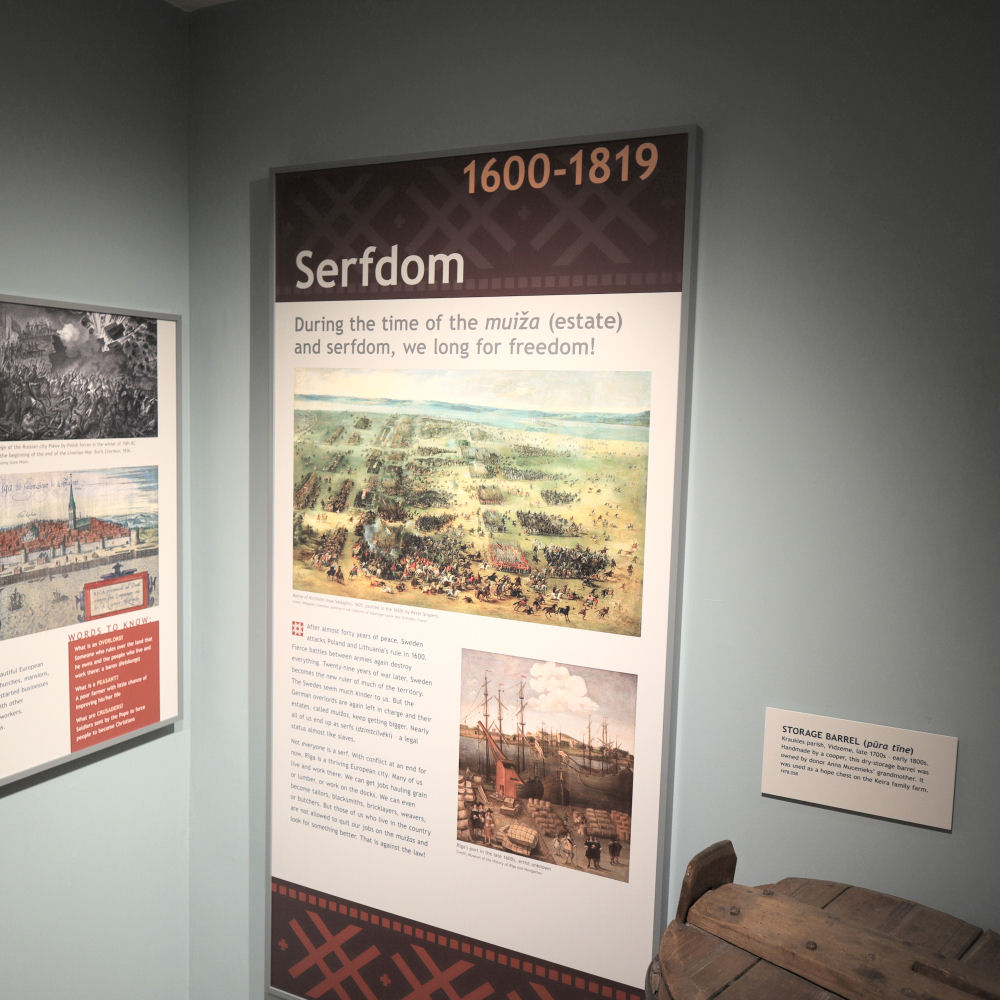

1819-1917 National Awakening
Serfdom is abolished 1818-1820 in Kurzeme and Vidzeme, but lasts until 1863 (with the rest of Russia) in Latgale. Latvians become indentured servants, still unable to own land. They begin to dream of a Latvian homeland.

1905
Czarist troops fired on demonstrators led by Father Gapon in front of the Winter Palace in St. Petersburg on January 9, 1905, killing 200. Four days later, troops shot and killed 70 more demonstrators in Riga. Latvians supported and voted for Bolsheviks, hoping for autonomy under Russia. Support for independence solidified when that hope faded.

1917-1920 The Great War
At one point, the newly declared provisional government of Latvia was ensconsed on a ship in Liepāja harbor. Germans — defeated in the west but supported against Russia in the east, held a small corner of Latvia, Russians the rest. Latvians allied with Germans drove out the Russians and then rid themselves of the Germans to finally achieve independence.

1920-1939 Freedom!
Latvia was left utterly devastated, but free. Its industry evacuated to Russia, saboutaged, or destroyed, the government broke up the massive baronial manorlands in the Land Reform of 1920, founding an agrarian nation of farmer-homesteaders. Latvia rebuilt with industrious zeal.

1940-1985 Terror!
Latvia once again became a stomping ground for foreign powers: the USSR, the Nazis and the Holocaust, and the USSR once again. Already promised by FDR to Stalin in 1943, Latvia, Lithuania, and Estonia were the only countries to disappear off the map after WWII, albeit never legally incorporated into the Soviet Union.
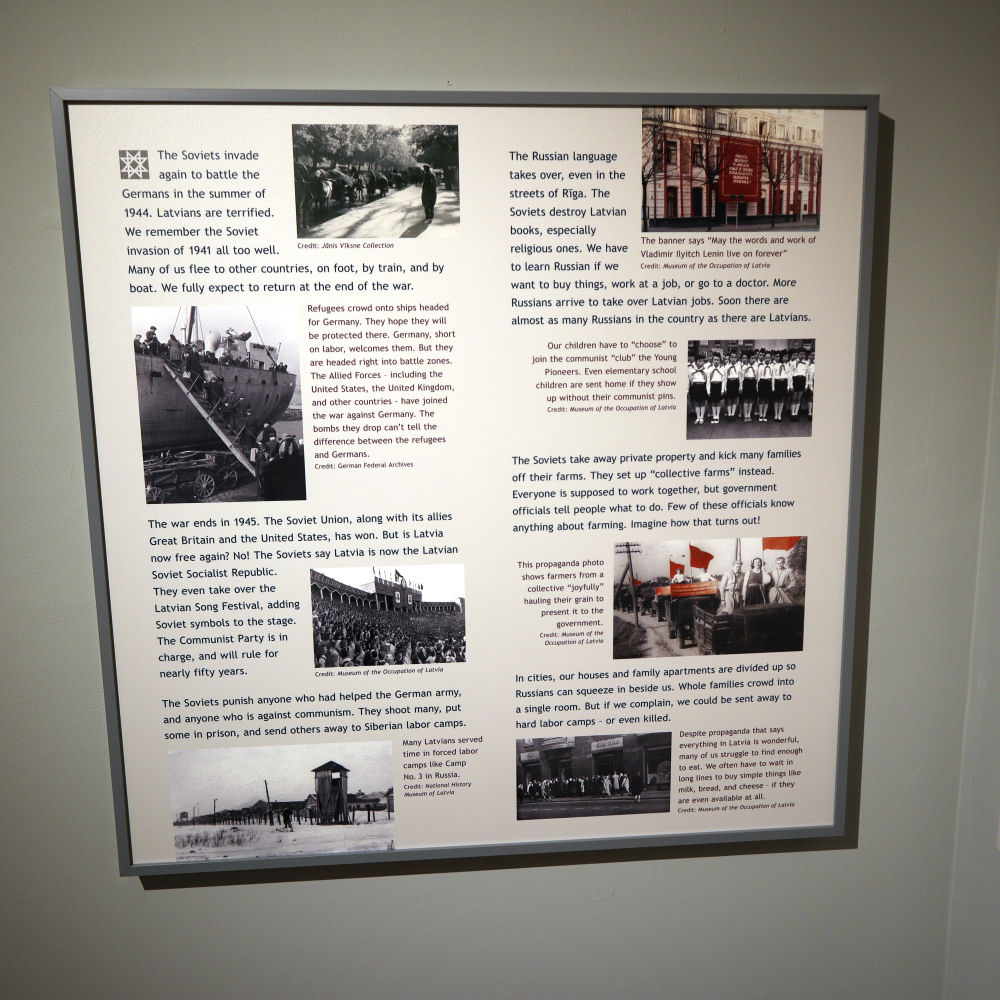
Soviets return
Some 170,000 Latvians fled the reinvading Red Army. For those who remained behind, the Soviet return marked a return of brutality, of more mass deportations, and Russification. Latvians become second-class citizens forced to sing the glories of Stalin.

The DP Camps
Tens of thousands of Latvian refugees spent the next five years after the war in Displaced Persons camps in war-torn Allied-occupied Germany. Latvians established their own schools, workshops, hospitals, working with scraps, obsessed with preserving their culture and way of life, whatever the circumstances.

Preservation
Latvians fleeing into exile took only what they could carry. Taking only those few things that were most precious to them, the most evocative of home. Peters still has his parents’ wooden suitcases, one of which still holds his paternal grandmother’s-woven cloth. Peters’s (second) cousin’s mother’s loom built from scraps in the DP camps made it to a new home in Australia.
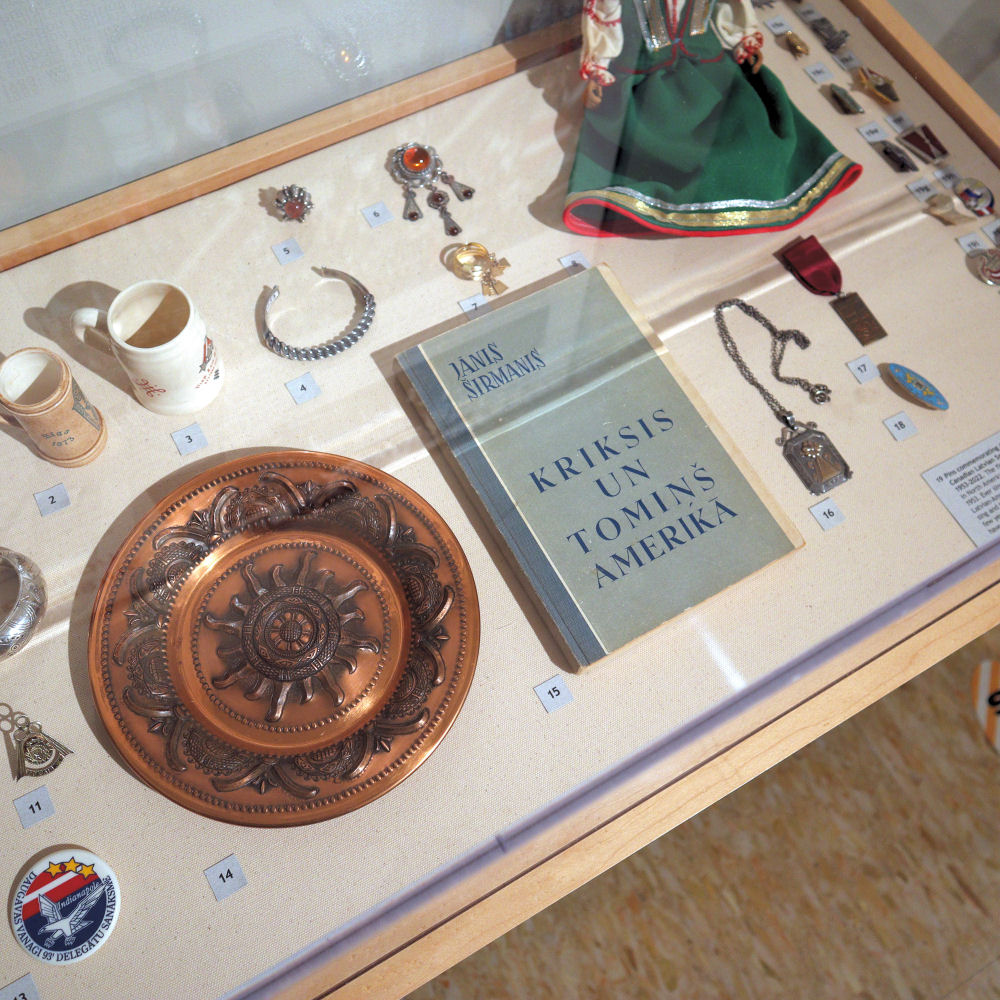
Into the unknown
How best to prepare for a new life in a new country? Language lessons. Pocket dictionaries. And for those heading to America, Jānis Širmanis’s Kriksis un Tomiņš Amērikā, Kriksis (a classic dog’s name) and “little” Tom in America, a collection of stories with which to acquaint young readers with the unique aspects and customs of their new home.
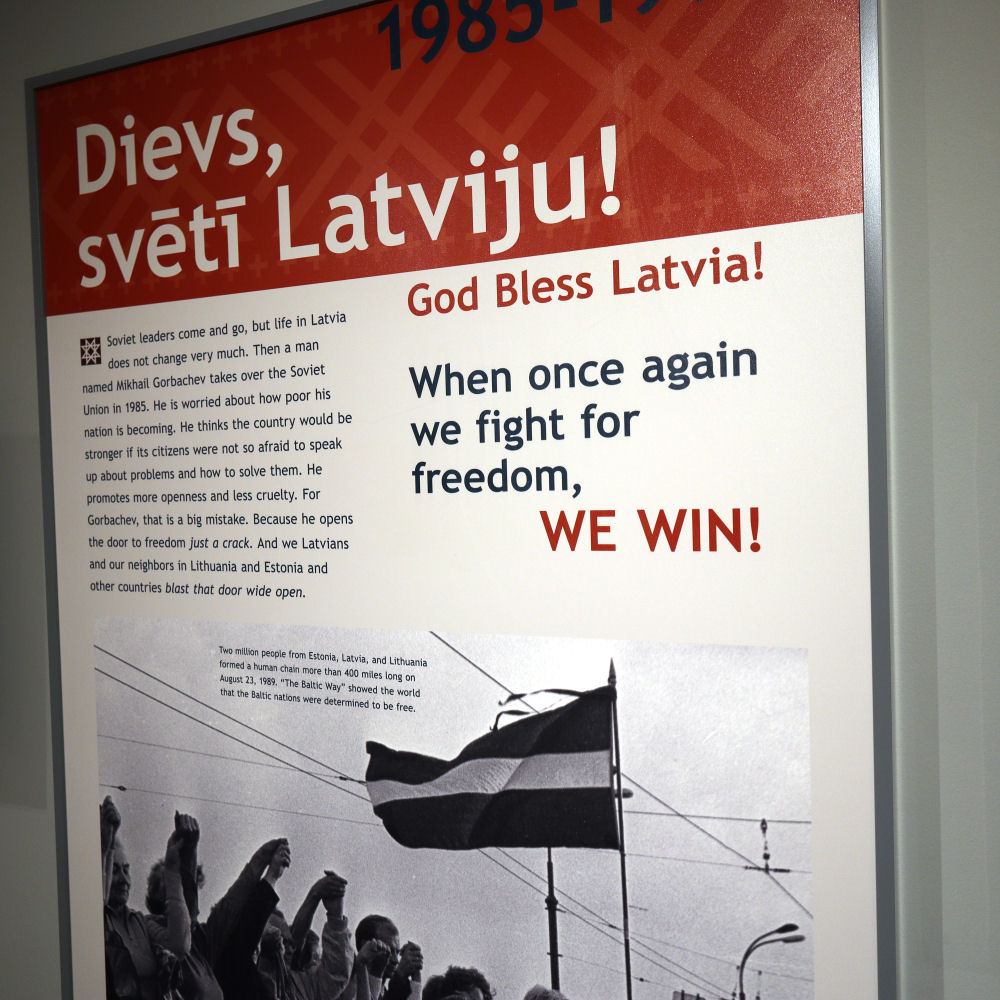
1985-1991 Dievs Svētī Latviju!
God Bless Latvia! Gorbachov’s rise in 1985 and his introduction of glasnost and perestroika opened the door. The Soviet Union swallowed the Baltics twice in WWII but neither social reforms nor the passage of time could stave off the geopolitical indigestion which hastened, perhaps even triggered, its demise. Latvia fully restored its independence in 1991.

Who are the Latvians?
Latvian and Lithuanian are the oldest living Indo-European languages — some 3,000 to 3,500 years old. Their sister peoples are heirs and custodians to a unique and rich cultural heritage.
